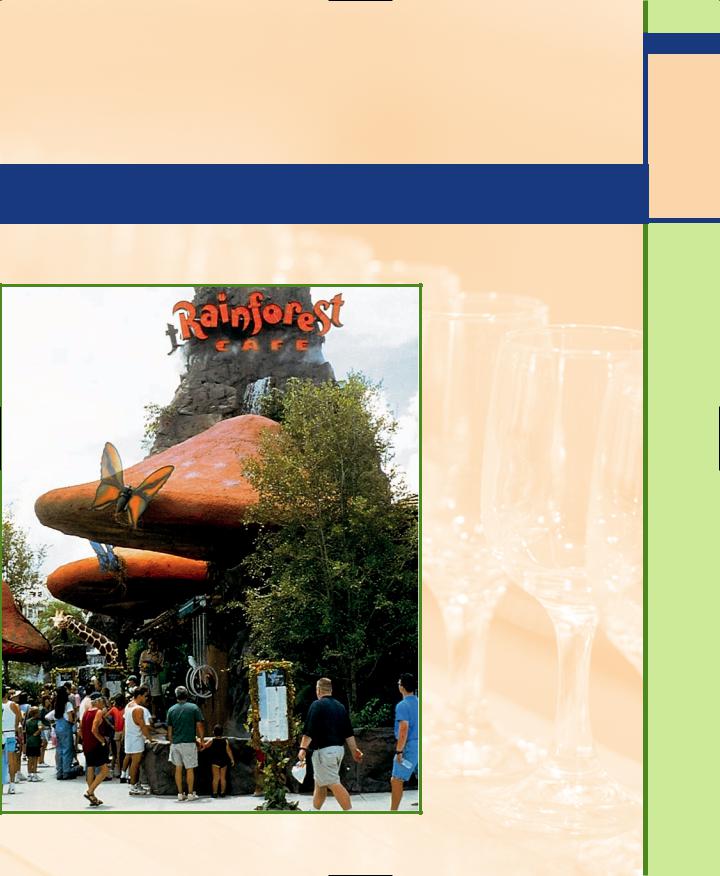
- •CONTENTS
- •PREFACE
- •Content—Benefits for Students
- •Content—Benefits for Instructors
- •Features of the Book for Students and Instructors
- •Supplementary Materials
- •Acknowledgments
- •What Is Hospitality Management?
- •The Manager’s Role in the Hospitality Industry
- •Why Study in a Hospitality Management Program?
- •Planning a Career
- •Employment as an Important Part of Your Education
- •Getting a Job
- •Employment at Graduation
- •The Outlook for Hospitality
- •Summary
- •Managing Change
- •Demand
- •Supply
- •Workforce Diversity
- •The Impact of Labor Scarcity
- •Summary
- •The Varied Field of Food Service
- •The Restaurant Business
- •The Dining Market and the Eating Market
- •Contemporary Popular-Priced Restaurants
- •Restaurants as Part of a Larger Business
- •Summary
- •Restaurant Operations
- •Making a Profit in Food Service Operations
- •Life in the Restaurant Business
- •Summary
- •Chain Restaurant Systems
- •Independent Restaurants
- •Franchised Restaurants
- •Summary
- •Competitive Conditions in Food Service
- •The Marketing Mix
- •Competition with Other Industries
- •Summary
- •Self-Operated Facilities
- •Managed-Services Companies
- •Business and Industry Food Service
- •College and University Food Service
- •Health Care Food Service
- •School and Community Food Service
- •Other Segments
- •Vending
- •Summary
- •Consumer Concerns
- •Food Service and the Environment
- •Technology
- •Summary
- •The Evolution of Lodging
- •Classifications of Hotel Properties
- •Types of Travelers
- •Anticipating Guest Needs in Providing Hospitality Service
- •Service, Service, Service
- •Summary
- •Major Functional Departments
- •The Rooms Side of the House
- •Hotel Food and Beverage Operations
- •Staff and Support Departments
- •Income and Expense Patterns and Control
- •Entry Ports and Careers
- •Summary
- •The Economics of the Hotel Business
- •Dimensions of the Hotel Investment Decision
- •Summary
- •The Conditions of Competition
- •The Marketing Mix in Lodging
- •Product in a Segmented Market
- •Price and Pricing Tactics
- •Place—and Places
- •Promotion: Marketing Communication
- •Summary
- •The Importance of Tourism
- •Travel Trends
- •The Economic Significance of Tourism
- •The United States as an International Tourist Attraction
- •Businesses Serving the Traveler
- •Noneconomic Effects of Tourism
- •Summary
- •Motives and Destinations
- •Mass-Market Tourism
- •Planned Play Environments
- •Casinos and Gaming
- •Urban Entertainment Centers
- •Temporary Attractions: Fairs and Festivals
- •Natural Environments
- •On a Lighter Note. . .
- •Summary
- •Management and Supervision
- •The Economizing Society
- •The Managerial Revolution
- •Management: A Dynamic Force in a Changing Industry
- •What Is Management?
- •Summary
- •Why Study Planning?
- •Planning in Organizations
- •Goal Setting
- •Planning in Operations
- •The Individual Worker as Planner
- •Long-Range Planning Tools
- •Summary
- •Authority: The Cement of Organizations
- •Departmentalization
- •Line and Staff
- •Issues in Organizing
- •Summary
- •Issues in Human-Resources Management
- •Fitting People to Jobs
- •Recruiting
- •Selection and Employment
- •Training
- •Retaining Employees
- •Staff Planning
- •Summary
- •The Importance of Control
- •Control and the “Cybernetic Loop”
- •Tools for Control
- •Summary
- •Leadership as Viewed by Social Scientists
- •Why People Follow
- •Leadership Theories
- •Communication
- •The Elements of Leading and Directing
- •Developing Your Own Leadership Style
- •Summary
- •A Study of Service
- •Rendering Personal Service
- •Managing the Service Transaction
- •How Companies Organize for Service
- •Summary
- •INDEX

Life in the Restaurant Business |
119 |
property taxes or insurance. The same is true of depreciation, which is a bookkeeping entry to write off the cost of a capital asset. Interest varies, of course, with the size of the debt and the interest rate.
By categorizing cost information in this way, we focus attention on the operation’s key variables. The cost percentages also reflect the efficiency of various segments of an operation. Food costs reflect management pricing and the kitchen crew’s efficiency. Labor costs reflect efficiency in employee scheduling and the adequacy of sales volume in proportion to the operation’s crew size. Results can be improved by either reducing employee hours or increasing sales.
Two key operating statistics are covers and check averages. The number of covers refers to the number of guests. (“Guest count” is an alternative term.) The check average can be what it sounds like, the average dollar amount of a check. Because parties (a group of guests seated together) vary in size, however, the check average is usually quoted as the average sale per guest. This figure is found by dividing the total dollar sales by the number of guests served during the period and is sometimes referred to as the average cover.
Figure 4.2 shows an example of a restaurant statement of income and expenses (also called an operating statement or a profit-and-loss statement). This statement shows the relationship of the costs we have just discussed and also how the check averages are computed.
As a final way to compare and contrast differing restaurants, Table 4.1 presents selected average operating ratios for the kinds of restaurants we described in the previous chapter.
Life in the Restaurant Business
The decision of whether or not to work in the restaurant business is really a decision about the kind of life you want to lead. Weekend and holiday work is common, and workweeks of 50 and 60 hours are, too, especially while you are working your way up in management. The work is often physically demanding because you are
on your feet, under pressure, and in a hurry for most of the working day.
On the other hand, it is an exciting business. It involves working with people—both employees and guests—in a way that is very rewarding. Every day—every meal—is a new challenge, and there are literally hundreds of opportunities to make people feel good. Few things are as pleasant as the end of a meal when a restaurant crew can take satisfaction in the success of its joint efforts.

120 |
Chapter 4 Restaurant Operations |
STATEMENT OF INCOME AND EXPENSES |
|
|
Suburban Restaurant |
|
|
Year Ending December 31, 20XX |
|
|
SALES |
|
|
Food |
$962,400 |
80.2% |
Beverage |
237,600 |
19.8 |
Total sales |
1,200,000 |
100.0 |
COST OF SALES |
|
|
Food |
$348,400 |
36.2% |
Beverage |
66,100 |
27.8 |
Total cost of sales |
414,500 |
34.5 |
GROSS PROFIT |
785,500 |
65.5 |
CONTROLLABLE EXPENSES |
|
|
Payroll |
$338,400 |
28.2% |
Employee benefits |
62,400 |
5.2 |
Direct operating expenses |
64,800 |
5.4 |
Music and entertainment |
3,600 |
0.3 |
Advertising and promotion |
22,800 |
1.9 |
Utilities |
38,400 |
3.2 |
Administrative and general |
46,800 |
3.9 |
Repairs and maintenance |
21,600 |
1.8 |
Total controllable expenses |
598,800 |
49.9 |
INCOME BEFORE CAPITAL COSTS |
$186,700 |
15.6% |
CAPITAL COSTS |
|
|
Rent, property taxes, and insurance |
$84,000 |
7.0% |
Interest and depreciation |
46,800 |
3.9 |
Total capital costs |
130,800 |
10.9 |
NET PROFIT BEFORE INCOME TAXES |
$56,400 |
4.7% |
Number of covers served |
74,918 |
|
Food check average |
$12.85 |
|
Beverage check average |
$3.17 |
|
Total check average |
$16.02 |
|
Figure 4.2
Restaurant statement of income and expenses.

Life in the Restaurant Business |
121 |
TABLE 4.1 |
|
|
|
Comparison of U.S. Restaurant Operating Statistics |
|
||
LIMITED SERVICE FULL-SERVICE (UNDER $15) |
FULL-SERVICE ($15 TO $24.99) |
||
Food costa |
31.3% |
32.6% |
36.4% |
Beverage costb |
30.0% |
30.0% |
28.4% |
Product costc |
30.8% |
32.0% |
34.1% |
Payroll and related costsd |
30.8% |
34.0% |
34.0% |
Prime coste |
61.6% |
66.0% |
68.1% |
Occupancy and capital costsf |
9.4% |
8.0% |
8.9% |
Profit before income taxes |
7.3% |
5.4% |
4.0% |
aFood cost as percentage of food sales. bBeverage cost as percentage of beverage sales.
cTotal food and beverage cost as percentage of total food and beverage sales. dIncludes employee benefits.
eTotal of product cost and labor cost.
fIncludes occupancy costs, depreciation, and interest expense.
Source: National Restaurant Association, “Restaurant Industry Operations Report—2004.”
SALARY LEVELS
According to the Bureau of Labor Statistics, the median salary for food service managers in 2004 was just under $40,000. Keep in mind that the salary level is obviously dependent upon geographic location, the restaurant company, length of service, sales volume, and so forth. Some segments are known to pay more than others, for instance, managers in the casual/theme segment are among the highest paid. On the other hand, the average salary for unit managers of family restaurants tends to be on the lower side.
Bonuses can also add an additional $2,000 to $10,000 at the unit level, again depending upon the segment and individual company policies.1 Restaurant companies tend to compensate their general managers significantly better than they do managers at the assistant level. After all, it is the general manager who is ultimately responsible for the performance of the unit. Employers tend to view the assistant manager’s position as an entry-level management position. The same compensation survey by the NRA indicated that the median salary for assistant managers was $28,000. The typical experience requirement for this position is between one and three years. The time that it takes to achieve the level of general manager has gotten progressively shorter over time but is between three and six years for most chains. On the lower end of the spectrum are management trainees, earning $25,000, and at the upper end, regional managers (of chains), earning $62,500. Chefs’ earnings ranged from $30,000 for pastry chefs to $48,000 for executive chefs (including, on average, a bonus of $5,000).2

122 |
Chapter 4 Restaurant Operations |
Another salary survey by Hospitality Valuation Services looked at the compensation of higher level managers. The median salary for Directors ranged from $76,000 to $97,000; median salaries for Vice Presidents ranged from $133,000 to $165,000, and median salaries for CEOs was $400,999.3
As we are dealing with averages, there are many people earning both more and less than these amounts. There is a considerable range in earnings because pay depends on the size of the operation, profit levels, and the responsibilities involved. Nevertheless, the figures give benchmarks that you may find useful.
Summary
Agood way to structure your observation of food service is around the major divisions of the front of the house, the back of the house, and the office or the administrative function, which is the way we have organized this chapter. Guest satisfaction, personal service, and accounting for sales are the major responsibilities of the front of the house. Food quality as well as food safety, sanitation, and food cost control are crucial in the back of the house. The office staff provides administrative assistance to managers and handles routine accounting and cost control functions. It is vital to ensure that there is some kind of management presence whenever an operation’s employees are at work. The food service day revolves around opening and closing routines and rush periods at meals. We covered a variety of issues relating to revenues and costs. Food service operations can be made profitable by increasing revenues or decreasing costs. Sales can be increased by selling more to existing customers or by broadening the customer base. Costs must be reduced through greater efficiency, rather than by cheapening the product and service. In operations, the effectiveness of results is measured with financial statements, particularly the statement of income and ex-
pense, and in operating statistics and ratios.
Key Words and Concepts
Front of the house |
Management presence |
Back of the house |
Opening and closing |
Guest satisfaction |
Food safety |
Check control |
Sanitation |
Credit card control |
Increasing sales |
Cash control |
Bundling |

Summary 123
Reducing costs |
Covers |
Cost of sales |
Check average |
Controllable expenses |
|
Review Questions
1.What are the most important elements of quality in food service? How are they attained?
2.What is meant by management presence? Why is it important? Have you seen it provided in operations in which you have worked? What are some of the consequences of a lack of management presence?
3.What characteristics do you think are important in a person who chooses to work in food service operations?
4.What pitfalls can you see in the attempts to increase sales? To reduce costs?
5.What are the major approaches to increasing profit? Which is the best way? Why? What are its dangers?
6.What are the main controllable costs? Why are they called controllable?
Internet Exercises
1.Site name: All Food Business
URL: www.allfoodbusiness.com/job_descriptions.php
Background information: Provides food service industry information and resources
free of charge.
Site name: Famous Dave’s
URL: www.famousdaves.com/careers/Docs/Restaurant%20Manager%20Job%
20Description.pdf
Background information: Famous Dave’s is a chain of barbeque restaurants headquartered in Minnetonka, MN.
Site name: Zoe’s Kitchen
URL: www.zoeskitchen.com/MANAGER_OPERATOR.pdf
Zoe’s is a small chain of restaurants headquartered in Bir-
Site name: Red Lobster
URL: www.redlobster.com/jobs/management_positions.asp

124 |
Chapter 4 Restaurant Operations |
Background information: Red Lobster is a chain seafood restaurant and is part of Darden Restaurants, Inc. It was built on the promise of offering great-tasting seafood at a value price.
Exercises:
a.Review the management job descriptions for each of the restaurants above. Describe the differences and similarities among the restaurant groups and compare them with those indicated in the textbook.
b.What training is provided by the restaurants to prepare entry-level managers for positions in their organization? Which restaurant company seems to provide the best training?
c.Based on the job descriptions indicated on the Web sites above, describe what you need to do to prepare yourself for a restaurant manager position between now and graduation.
2.Site name: PayScale.com
URL: www.payscale.com/research/US/Job=Restaurant_Manager/Salary/show_all
Background information: PayScale is an online salary and benefit information source,
providing reliable and accurate compensation data for both employees and employers.
Site name: Bureau of Labor Statistics
URL: http://www.bls.gov/oes/current/oes119051.htm
Background information: The Bureau of Labor Statistics is the principal fact-finding agency for the Federal Government in the broad field of labor economics and statistics.
Site name: StarChefs.com
URL: http://www.starchefs.com/features/editors_dish/salary_survey/index.shtml
Background information: StarChefsTM is an award-winning online magazine, serving the food service industry and food aficionados since 1995.
Exercises:
a.Using the Web sites above, compare the salary levels for food service managers. Describe any differences and why you believe there is a difference.
b.Describe the difference that location in the United States makes for basically the same job. Other than cost of living, what would account for differences in salaries in various locations?
3.Site name: Key Operating Ratios for Restaurants
URL: http://www.wku.edu/~hrtm/wiley/foodratio
Background information: Comparisons of these indicators with earlier operating re-
sults and with the budget provide important clues to an operation’s problems or
success.

Summary 125
Exercises: Based on the Key Operating Ratio formulas in Chapter 4 of the textbook and the sample data on the above Web page, calculate:
a.Average sale per guest
b.Average check
c.Average number of guests per check
d.Food cost percentage
e.Beverage cost percentage
Notes
1.National Restaurant Association, “2001 Compensation for Salaried Personnel in Restaurants.” Page 2.
2.Ibid.
3.Hospitality Compensation Exchange, HVS International, 2005.

The Hospitality Industry
(Courtesy of Rainforest Cafe.)

C H A P T E R FOINV E
RestaurantTheHospitalityIndustry
IndustryOrganization:and You
Chain, Independent,
or Franchise?
The Purpose of This Chapter
his chapter is concerned with the relationship between the form of ownership of the restaurant
Tand the likelihood of success. Chains have many advantages, but so do independents. The advantage—or disadvantage—often depends on the situation; factors such as location, type of
operation, and the operation’s relationship to the community all have a bearing.
Somewhere between private ownership and chain ownership is the franchised operation. Franchisees have some of the independence of ownership but agree to give up much of it for the right to be a part of a successful concept. Because franchises play such an important role in food service, it is essential for you to assess this means of organizing ownership, too.
We sometimes hear that the days of the independent restaurant are past. Although this is certainly not true, the role of the independent restaurant in the industry is changing. Chains have advantages in some industry segments, but independents have strengths that are hard to match in others. It is useful, therefore, to discuss the competitive advantages of both independents and chains. Most restaurant chains include company-owned units as well as franchised units. Franchised units have some aspects in common with chain operations and others in common with independents. For that reason, the chapter concludes with a discussion of franchised restaurant systems.
THIS CHAPTER SHOULD HELP YOU
1.List the relative advantages and disadvantages of chains and independents in the following key areas: marketing and brand recognition; site selection; access to capital; purchasing economies; control and information systems; new product development; and human resources.
